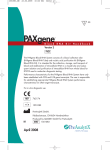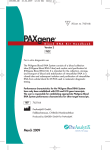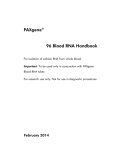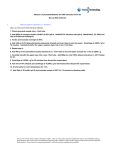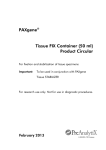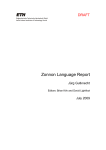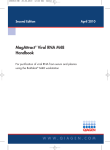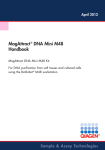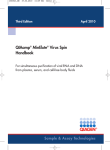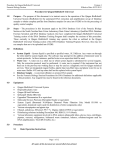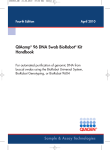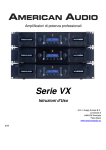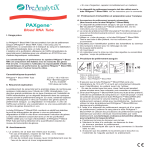Download PAXgene Blood RNA MDx Kit Handbook
Transcript
Pax1063012-HB 30.04.2010 11:38 Uhr Seite U1 Second Edition PAXgene ™ Blood RNA MDx Kit Handbook For automated purification of cellular RNA from whole blood using the BioRobot® MDx or the BioRobot Universal System Important: To be used only in conjunction with PAXgene Blood RNA Tubes For Research Use Only. Not for use in diagnostics procedures. April 2010 Pax1063012-HB 30.04.2010 11:38 Uhr Seite 2 Trademarks: PAXgene™, PreAnalytiX™ (PreAnalytiX GmbH.); QIAGEN®, BioRobot® (QIAGEN Group); BD Hemogard™, BD Vacutainer®, Hemogard®, Safety-Lok™ (Becton Dickinson and Company, Franklin Lakes, NJ, USA); Eppendorf®, Multipette® (Eppendorf-Netheler-Hinz GmbH); NASBA® (Organon Teknika); Speed Vac® (Savant Instruments, Inc.). The PAXgene Blood RNA MDx System is for Research Use Only. Not for use in diagnostics procedures. No claim or representation is intended to provide information for the diagnosis, prevention, or treatment of a disease. The PCR process is covered by the foreign counterparts of U.S. Patents Nos. 4,683,202 and 4,683,195 owned by F. Hoffmann-La Roche Ltd. © 2005 PreAnalytiX GmbH, all rights reserved. PreAnalytiX Company PreAnalytiX GmbH Feldbachstrasse CH – 8634 Hombrechtikon Switzerland www.preanalytix.com PreAnalytiX Distributors PreAnalytiX products are manufactured for PreAnalytiX by QIAGEN or BD and are distributed for PreAnalytiX by QIAGEN or BD. Products cannot be ordered at PreAnalytiX GmbH. Please see the last page for contact information for your local PreAnalytiX distributor. 2 PAXgene Blood RNA MDx Kit Handbook 04/2010 Pax1063012-HB 30.04.2010 11:38 Uhr Seite 3 Contents Kit Contents 4 Shipping and Storage 5 Product Use Limitations 5 Product Warranty and Satisfaction Guarantee 5 Safety Information 6 Quality Control 7 Technical Assistance 7 Introduction 8 Principle and procedure Equipment and Reagents to Be Supplied by User 8 10 Protocols Purification of RNA on the BioRobot MDx from Whole Blood Collected in PAXgene Blood RNA Tubes 11 Purification of RNA on the BioRobot Universal System from Whole Blood Collected in PAXgene Blood RNA Tubes 14 Troubleshooting Guide 17 Appendix A: General Remarks on Handling RNA 21 Appendix B: Quantification and Determination of Quality of Total RNA 22 Ordering Information 24 PreAnalytiX Worldwide PAXgene Blood RNA MDx Kit Handbook 04/2010 3 Pax1063012-HB 30.04.2010 11:38 Uhr Seite 4 Kit Contents PAXgene Blood RNA MDx Kit Catalog no. Number of preps (4) 762431 4 x 96 PAXgene 96 RNA Plates 4 PAXgene 96 Filter Plates 4 Buffer BR1 (Resuspension Buffer) 170 ml Buffer BR2 (Binding Buffer)* 2 x 220 ml Buffer BR3 (Wash Buffer)* 2 x 450 ml Buffer BR4 (Wash Buffer)† 2 x 100 ml Buffer BR5 (Elution Buffer) 8 x 10 ml Top Elute Fluid 110 ml Proteinase K 2 x 10 ml RNase-Free DNase Set For 8 x 50 reactions Bottle, 500 ml Ethanol p.a. 1 Sample Tube 2 ml Square-Well Blocks 1 x 16 ‡ 8 Elution Microtubes CL, racked‡ 4 x 96 Caps for Elution Microtubes‡ 55 x 8 ‡ Disposable Troughs, 30 ml 2 x 10 ® Secondary Hemogard Closures 8 x 50 Q-Card PAXgene RNA MDx 1 Handbook 1 * Contains a guanidine salt. See page 6 for safety information. † Buffer BR4 is supplied as a concentrate. Before using for the first time, add 4 volumes of ethanol (96–100%, purity grade p.a.) as indicated on the bottle to obtain a working solution. ‡ Also available separately. See page 25 for ordering information. 4 PAXgene Blood RNA MDx Kit Handbook 04/2010 Pax1063012-HB 30.04.2010 11:38 Uhr Seite 5 Shipping and Storage Except for the RNase-Free DNase Set, the remaining components of the PAXgene Blood RNA MDx Kit can be stored at room temperature (15–25°C). The PAXgene Blood RNA MDx Kit contains ready-to-use proteinase K solution that can be stored at room temperature (15–25°C). To store for extended periods of time, we suggest keeping the proteinase K at 2–8°C. The QIAGEN® RNase-Free DNase Set is shipped at room temperature. All components should be stored immediately upon receipt at 2–8°C. When stored at 2–8°C and handled correctly, the buffers and the lyophilized enzyme can be kept for at least 9 months without showing any reduction in performance. Product Use Limitations For Research Use Only. Not for use in diagnostics procedures. No claim or representation is intended to provide information for the diagnosis, prevention, or treatment of a disease. The performance characteristics of this product have not been fully established. Product Warranty and Satisfaction Guarantee PreAnalytiX guarantees the performance of all products in the manner described in our literature. PreAnalytiX products are manufactured for PreAnalytiX by QIAGEN or BD and are distributed for PreAnalytiX by QIAGEN or BD. Should any product fail to perform satisfactorily due to any reason other than misuse, QIAGEN, the distributor of PreAnalytiX products, will replace it free of charge or refund the purchase price. PreAnalytiX reserves the right to change, alter, or modify any product to enhance its performance and design. If a PreAnalytiX product does not meet your expectations, simply call your local QIAGEN Technical Service Department or other PreAnalytiX distributor. We will credit your account or exchange the product — as you wish. PAXgene Blood RNA MDx Kit Handbook 04/2010 5 Pax1063012-HB 30.04.2010 11:38 Uhr Seite 6 Safety Information When working with chemicals, always wear a suitable lab coat, disposable gloves, and protective goggles. To avoid the risk of infection (e.g., from HIV or Hepatitis B viruses) or injury when working with biological and chemical materials, always wear a suitable lab coat, disposable gloves, and protective goggles. For more information, please consult the appropriate material safety data sheets (MSDSs). These are available online in convenient and compact PDF format at www.preanalytix.com/rna msds.asp where you can find, view, and print the MSDS for each PreAnalytiX kit and kit component. CAUTION: DO NOT add bleach or acidic solutions directly to the sample-preparation waste. Buffer BR2 contains guanidine thiocyanate and Buffer BR3 contains a small amount of guanidine thiocyanate, which can form highly reactive compounds when combined with bleach. If liquid containing this buffer is spilt, clean with suitable laboratory detergent and water. If the spilt liquid contains potentially infectious agents, clean the affected area first with laboratory detergent and water, and then with 1% (v/v) sodium hypochlorite. The following risk and safety phrases apply to components of the PAXgene Blood RNA MDx Kit. Buffer BR2 Contains guanidine thiocyanate: harmful. Risk and safety phrases:* R20/21/22-32, S13-26-36-46 Buffer BR3 Contains ethanol: flammable. Risk and safety phrases:* R10 Proteinase K Contains proteinase K: sensitizer, irritant: Risk and safety phrases:* R36/37/3842/43, S23-24-26-36/37 * R10: Flammable; R20/21/22: Harmful by inhalation, contact with skin, and if swallowed; R32: Contact with acids liberates very toxic gas; R36/37/38: Irritating to eyes, respiratory system, and skin; R42/43: May cause sensitization by inhalation and skin contact; S13: Keep away from food, drink, and animal feedingstuffs; S23: Do not breathe vapor; S24: Avoid contact with skin; S26: In case of contact with eyes, rinse immediately with plenty of water and seek medical advice; S36: Wear suitable protective clothing; S36/37: Wear suitable protective clothing and gloves; S46: If swallowed, seek medical advice immediately and show the container or label. 6 PAXgene Blood RNA MDx Kit Handbook 04/2010 Pax1063012-HB 30.04.2010 11:38 Uhr Seite 7 DNase I (in the RNase-Free DNase Set) Contains deoxyribonuclease: sensitizer. Risk and safety phrases:* R42/43, S22-24-2636/37 24-hour emergency information Emergency medical information in English, French, and German can be obtained 24 hours a day from: Poison Information Center Mainz, Germany Tel: +49-6131-19240 Quality Control In accordance with QIAGEN’s ISO-certified Total Quality Management System, each lot of PAXgene Blood RNA Kit is tested against predetermined specifications to ensure consistent product quality. Technical Assistance Technical assistance with PreAnalytiX products is provided by QIAGEN, the distributor for PreAnalytiX. The Technical Service Departments at QIAGEN are staffed by experienced scientists with extensive practical and theoretical expertise in molecular biology. If you have any questions or experience any difficulties regarding the PAXgene Blood RNA MDx Kit, please contact one of the Technical Service Departments listed the last page. PreAnalytiX customers are a major source of information regarding advanced or specialized uses of our products. This information is helpful to other scientists as well as to the researchers at PreAnalytiX. We therefore encourage you to contact us through QIAGEN’s Technical Service Departments if you have any suggestions about product performance or new applications and techniques. * R42/43: May cause sensitization by inhalation and skin contact; S22: Do not breathe dust; S24: Avoid contact with skin; S26: In case of contact with eyes, rinse immediately with plenty of water and seek medical advice; S36/37: Wear suitable protective clothing and gloves. PAXgene Blood RNA MDx Kit Handbook 04/2010 7 Pax1063012-HB 30.04.2010 11:38 Uhr Seite 8 Introduction The PAXgene Blood RNA MDx Kit allows the automated, high-throughput purification on the BioRobot MDx or BioRobot Universal System of total RNA from 2.5 ml human whole blood collected into PAXgene Blood RNA Tubes. The PAXgene Blood RNA MDx Kit is for laboratory use. Principle and procedure The simple procedure begins with a centrifugation step to pellet the contents of each PAXgene Blood RNA Tube. Proteinase K and an optimized incubation buffer are added to digest proteins. With the BioRobot MDx, the pellets are resuspended manually, and the tubes are then transferred to the workstation. On the BioRobot Universal System, the tubes are transferred to the workstation and the pellets are automatically resuspended by the integrated shaker on the workstation. After setup of buffers and plasticware, guided by the QIAsoft Operating System, the BioRobot MDx or BioRobot Universal System carries out the fully automated RNA purification procedure. Lysates are applied to a PAXgene 96 Filter Plate (see flowchart, next page). Ethanol is added to the flow-throughs to adjust binding conditions, and the resulting samples are applied to a PAXgene 96 RNA Plate. RNA is selectively bound to the PAXgene 96 RNA membrane and contaminants pass through. The bound RNA is washed with Buffer BR3 and ethanol. Residual DNA is removed through a DNase I digestion on the PAXgene 96 membrane. Remaining contaminants are removed in three efficient wash steps and RNA is eluted in Buffer BR5. Following purification, a final heat treatment of the eluate enhances performance in downstream applications. Typical yields of RNA isolated from 2.5 ml healthy, human, whole blood (4.8 x 106 – 1.1 x 107 leukocytes/ml) are ≥3 µg for >95% of the samples processed. Since yields are highly donor-dependent, individual yields may vary. The purified RNA is ready for immediate use. Downstream applications that use RNA include RT-PCR and NASBA®, cDNA synthesis, quantitative RT-PCR, RNase and S1 nuclease protection, expressionarray and expression-chip analysis, poly A+ RNA selection, northern, dot, and slot blot analysis, and primer extension. 8 PAXgene Blood RNA MDx Kit Handbook 04/2010 Pax1063012-HB 30.04.2010 11:38 Uhr Seite 9 The PAXgene Blood RNA MDx Procedure Centrifuge to obtain pellet Add proteinase K Resuspend pellet (BioRobot MDx protocol) Square-well block Manual sample preparation Blood Transfer tubes to BioRobot workstation Resuspend pellet (BioRobot Universal System protocol) Proteinase K digestion, 65°C Transfer to PAXgene 96 Filter Plate Vacuum Bind RNA Wash 2x Vacuum Fully automated RNA purification Lysate clearing DNase I digestion Wash 3x Vacuum Pure RNA PAXgene Blood RNA MDx Kit Handbook 04/2010 9 Pax1063012-HB 30.04.2010 11:38 Uhr Seite 10 Equipment and Reagents to Be Supplied by User When working with chemicals, always wear a suitable lab coat, disposable gloves, and protective goggles. For more information, consult the appropriate material safety data sheets (MSDSs), available from the product supplier. For all protocols • PAXgene Blood RNA Tubes (cat. no. 762165) • A step dispenser, such as the Multipette® plus from Eppendorf (recommended for optimal processing)* • Square-well blocks (optional, cat. no. 19585)† • Elution Microtubes CL, racked (optional, cat. no. 1030483)† • Caps for Elution Microtubes (optional, cat. no. 1030481)† • Disposable Troughs, 30 ml (optional, cat. no. 9232764)† • Disposable gloves • 96–100% ethanol p.a. • Centrifuge capable of attaining 3000–5000 x g, equipped with a swing-out rotor and buckets to hold PAXgene Blood RNA Tubes • PAXgene 96 Incubator Block (cat. no. 9238279) • Incubator capable of 80°C • Scalpel or spatula to remove the lower plate from the elution microtube rack • Heavy plate to prevent caps from opening during incubation at 80°C • Ice For the BioRobot MDx protocol • BioRobot MDx workstation (cat. no. 900600) • A multitube vortexer, such as the VX2500 from VWR (recommended for optimal processing)* For the BioRobot Universal System protocol • BioRobot Universal System (cat. no. 9001094) • Shaker Adapter, 24-tube, PAXgene (cat. no. 9016753) * This is not a complete list of suppliers and does not include many important vendors of biological supplies. † Eight square-well blocks, 4 x 96 Elution Microtube CL racks, 55 x 8 Caps for Elution Microtubes, and 20 Disposable Troughs, 30 ml, are supplied with the kit. If one or more runs with 48 samples are processed, extra Elution Microtubes CL and Caps for Elution Microtubes are required, and it may be convenient to have additional extra plasticware available (see page 25 for ordering information). 10 PAXgene Blood RNA MDx Kit Handbook 04/2010 Pax1063012-HB 30.04.2010 11:38 Uhr Seite 11 BioRobot MDx Protocol: Purification of RNA on the BioRobot MDx from Whole Blood Collected in PAXgene Blood RNA Tubes Important points before starting • Blood must be collected in PAXgene Blood RNA Tubes (cat. no. 762165). • Use of a step dispenser, such as the Multipette plus from Eppendorf, and a multitube vortexer, such as the VX2500 from VWR, is recommended. • All steps of the PAXgene Blood RNA BioRobot MDx protocol for purification of total RNA should be performed at 18–25°C. Things to do before starting • After collection of the blood sample, it is important to incubate the PAXgene Blood RNA Tube for at least 2 hours at room temperature (15–25°C) before RNA purification. Incubation of the PAXgene Blood RNA Tube overnight may increase RNA yields in some cases. If the blood samples in the PAXgene Blood RNA Tubes were frozen, they must be thawed at room temperature for at least 2 hours before RNA purification. • Fill the ethanol bottle with 500 ml ethanol (96–100%, p.a.), and add 500 µl Buffer BR1. This allows the BioRobot MDx to detect the fill level in the ethanol bottle by conductivity measurements. • Buffer BR2 may form a precipitate upon storage. If necessary, warm to 37°C to redissolve. • Buffer BR4 is supplied as a concentrate. Before using for the first time, add 4 volumes of ethanol (96–100%, p.a.) to obtain a working solution. • Heat an incubator to 80°C for the final heat denaturation step. Place the PAXgene 96 Incubator Block into the incubator. • Prepare DNase I stock solution. Dissolve the solid DNase I (1500 Kunitz units per vial)* in 550 µl of RNase-free water (provided in the set). Take care that no DNase I is lost when opening the vial. Do not vortex the reconstituted DNase I. DNase I is especially sensitive to physical denaturation. Mixing should only be carried out by gently inverting the tube 10 times. Fill 2 ml tubes with 260 µl of this DNase stock solution each, and add 1800 µl Buffer RDD. For 48 samples, two 2 ml tubes with DNase reaction mixture are required; for 96 samples, four tubes are required. * Kunitz units are the commonly used units for measuring DNase I, defined as the amount of DNase I that causes an increase in A260 of 0.001 per minute per milliliter at 25°C, pH 5.0, with highly polymerized DNA as the substrate (Kunitz, M. [1950] J. Gen. Physiol. 33, 349 and 363). PAXgene Blood RNA MDx Kit Handbook 04/2010 11 Pax1063012-HB 30.04.2010 11:38 Uhr Seite 12 Procedure BioRobot MDx 1. Centrifuge the PAXgene Blood RNA Tubes for 10 min at 3000–5000 x g using a swing-out rotor. Note: Use only round-bottomed tube adapters. Tubes may break during centrifugation if centrifuge adaptors with conical bottoms are used. To save time, the BioRobot MDx can be set up during this centrifugation step. Start the QIAsoft MDx Operating System and run the PAXgene 96 Blood RNA Protocol. Set up the plasticware, tips, and buffers according to the protocol instructions on the BioRobot MDx. 2. After centrifugation, remove the supernatant by decanting. Discard the supernatant, and save the pellet for resuspension in step 3. Carefully dry the rim of the tube with a clean paper towel. 3. Add 290 µl Buffer BR1 and 35 µl proteinase K. Close the tubes with the Secondary Hemogard Closures provided, and thoroughly resuspend the pellet by vortexing. Remove the closures and transfer the tube to a sample tracking system tube rack. To save time, mix the appropriate volumes of Buffer BR1 and proteinase K (for 48 samples, 14.5 ml Buffer BR1 and 1750 µl proteinase K; for 96 samples, 29.0 ml Buffer BR1 and 3500 µl proteinase K), and distribute 325 µl of the mixture into each tube using a step dispenser. For resuspension use a multitube vortexer. 4. Start the QIAsoft MDx Operating System and run the PAXgene 96 Blood RNA Protocol. Set up the plasticware, tips, and buffers according to the protocol instructions on the BioRobot MDx. To save time this step can be performed during the 10 min centrifugation in step 1. 5. Place the tubes (in the racks) onto the BioRobot MDx sample input area, and proceed with the PAXgene 96 Blood RNA Protocol. 6. After the BioRobot MDx protocol finishes, remove the elution microtubes, and seal them with the appropriate caps. 7. Remove the lower plate from the elution microtube rack using a scalpel or spatula. Place the elution microtube rack onto the PAXgene 96 Incubator Block preheated in the 80°C incubator, and incubate for 10 min in the incubator at 80°C. Place a heavy plate over the caps to prevent them from popping open. Denaturation of the eluate is essential for maximum efficiency in downstream applications, such as RT-PCR, other amplification reactions, or cDNA synthesis. It is not necessary to denature samples more than once; samples remain denatured after freezing and thawing. Note: The temperature of the eluate must reach at least 65°C but should not exceed 70°C. Using a heat block or other methods to denature the RNA may result in higher temperatures, leading to RNA degradation. 12 PAXgene Blood RNA MDx Kit Handbook 04/2010 Pax1063012-HB 8. 30.04.2010 11:38 Uhr Seite 13 After incubation, chill the elution microtubes immediately on ice. Put the bottom plate back onto the rack for storage. Store the purified RNA at –20°C or –70°C. Note: For quantification in Tris buffer, use the relationship A260 = 1 fi 44 µg/ml. 9. Check the report file generated at the end of each run to ensure that the automated procedure performed correctly. 10. After a 48-sample run, store the PAXgene 96 RNA plate and the PAXgene 96 Filter plate in its original packaging with a clean paper towel at the bottom. PAXgene Blood RNA MDx Kit Handbook 04/2010 13 BioRobot MDx For accurate quantification of RNA by absorbance at 260 nm, we recommend diluting the sample in 10 mM Tris·Cl, pH 7.5. Dilution of the sample in RNase-free water may lead to inaccurately low values. Use the buffer in which the RNA is diluted to zero the spectrophotometer, and make sure to add the same volume of Buffer BR5 as the volume of eluted RNA to be diluted. Buffer BR5 has high absorbance at 220 nm, which can lead to high background absorbance levels if the spectrophotometer is not properly zeroed. Pax1063012-HB 30.04.2010 11:38 Uhr Seite 14 Protocol: Purification of RNA on the BioRobot Universal System from Whole Blood Collected in PAXgene Blood RNA Tubes BioRobot Universal Important points before starting • Blood must be collected in PAXgene Blood RNA Tubes (cat. no. 762165). • Use of a step dispenser, such as the Multipette plus from Eppendorf, is recommended. • All steps of the PAXgene Blood RNA BioRobot Universal System protocol for purification of total RNA should be performed at 18–25°C. Things to do before starting • After collection of the blood sample, it is important to incubate the PAXgene Blood RNA Tube for at least 2 hours at room temperature before RNA purification. Incubation of the PAXgene Blood RNA Tube overnight may increase RNA yields in some cases. If the blood samples in the PAXgene Blood RNA Tubes were frozen, they must be thawed at room temperature for at least 2 hours before RNA purification. • Fill the ethanol bottle with 500 ml ethanol (96–100%, p.a.), and add 500 µl Buffer BR1. This allows the BioRobot Universal System to detect the fill level in the ethanol bottle by conductivity measurements. • Buffer BR2 may form a precipitate upon storage. If necessary, warm to 37°C to redissolve. • Buffer BR4 is supplied as a concentrate. Before using for the first time, add 4 volumes of ethanol (96–100%, p.a.) to obtain a working solution. • Heat an incubator to 80°C for the final heat denaturation step. Place the PAXgene 96 Incubator Block into the incubator. • Prepare DNase I stock solution. Dissolve the solid DNase I (1500 Kunitz units per vial)* in 550 µl of RNase-free water (provided in the set). Take care that no DNase I is lost when opening the vial. Do not vortex the reconstituted DNase I. DNase I is especially sensitive to physical denaturation. Mixing should only be carried out by gently inverting the tube 10 times. Fill 2 ml tubes with 260 µl of this DNase stock solution each, and add 1800 µl Buffer RDD. For 48 samples, two 2 ml tubes with DNase reaction mixture are required; for 96 samples, four tubes are required. * Kunitz units are the commonly used units for measuring DNase I, defined as the amount of DNase I that causes an increase in A260 of 0.001 per minute per milliliter at 25°C, pH 5.0, with highly polymerized DNA as the substrate (Kunitz, M. [1950] J. Gen. Physiol. 33, 349 and 363). 14 PAXgene Blood RNA MDx Kit Handbook 04/2010 Pax1063012-HB 30.04.2010 11:38 Uhr Seite 15 Procedure 1. Centrifuge the PAXgene Blood RNA Tubes for 10 min at 3000–5000 x g using a swing-out rotor. Note: Use only round-bottomed tube adapters. Tubes may break during centrifugation if centrifuge adaptors with conical bottoms are used. 2. After centrifugation, remove the supernatant by decanting. Discard the supernatant, and save the pellet. Carefully dry the rim of the tube with a clean paper towel. 3. Add 290 µl Buffer BR1 and 35 µl proteinase K. Transfer the tube to the Shaker Adapter, 24-tube, PAXgene. To save time, mix the appropriate volumes of Buffer BR1 and proteinase K (for 48 samples, 14.5 ml Buffer BR1 and 1750 µl proteinase K; for 96 samples, 29.0 ml Buffer BR1 and 3500 µl proteinase K), and distribute 325 µl of the mixture into each tube using a step dispenser. 4. Start the QIAsoft 5 Operating System and run the PAXgene 96 Blood RNA Protocol. Set up the plasticware, tips, and buffers according to the protocol instructions on the BioRobot Universal System. To save time this step can be performed during the 10 min centrifugation in step 1. 5. Place the tubes (in the Shaker Adapter) onto the shaker unit of the BioRobot Universal System, and proceed with the PAXgene 96 Blood RNA Protocol. 6. After the BioRobot Universal System protocol finishes, remove the elution microtubes, and seal them with the appropriate caps. 7. Remove the lower plate from the elution microtube rack using a scalpel or spatula. Place the elution microtube rack onto the PAXgene 96 Incubator Block preheated in the 80°C incubator, and incubate for 10 min in the incubator at 80°C. Place a heavy plate over the caps to prevent them from popping open. Denaturation of the eluate is essential for maximum efficiency in downstream applications, such as RT-PCR, other amplification reactions, or cDNA synthesis. It is not necessary to denature samples more than once; samples remain denatured after freezing and thawing. Note: The temperature of the eluate must reach at least 65°C but should not exceed 70°C. Using a heat block or other methods to denature the RNA may result in higher temperatures, leading to RNA degradation. PAXgene Blood RNA MDx Kit Handbook 04/2010 15 BioRobot Universal To save time, the BioRobot Universal System can be set up during this centrifugation step. Start the QIAsoft 5 Operating System and run the PAXgene 96 Blood RNA Protocol. Set up the plasticware, tips, and buffers according to the protocol instructions on the BioRobot Universal System. Pax1063012-HB BioRobot Universal 8. 30.04.2010 11:38 Uhr Seite 16 After incubation, chill the elution microtubes immediately on ice. Put the bottom plate back onto the rack for storage. Store the purified RNA at –20°C or –70°C. For accurate quantification of RNA by absorbance at 260 nm, we recommend diluting the sample in 10 mM Tris·Cl, pH 7.5. Dilution of the sample in RNase-free water may lead to inaccurately low values. Use the buffer in which the RNA is diluted to zero the spectrophotometer, and make sure to add the same volume of Buffer BR5 as the volume of eluted RNA to be diluted. Buffer BR5 has high absorbance at 220 nm, which can lead to high background absorbance levels if the spectrophotometer is not properly zeroed. Note: For quantification in Tris buffer, use the relationship A260 = 1 fi 44 µg/ml. 9. Check the report file generated at the end of each run to ensure that the automated procedure performed correctly. 10. After a 48-sample run, store the PAXgene 96 RNA plate and the PAXgene 96 Filter plate in its original packaging with a clean paper towel at the bottom. 16 PAXgene Blood RNA MDx Kit Handbook 04/2010 Pax1063012-HB 30.04.2010 11:38 Uhr Seite 17 Troubleshooting Guide This troubleshooting guide may be helpful in solving any problems that may arise. The scientists in QIAGEN Technical Services are always happy to answer any questions you may have about either the information and protocols in this handbook or molecular biology applications (see last page for contact). Comments and suggestions RNA degraded RNase contamination Check for RNase contamination of buffers. Although all buffers have been tested and are guaranteed RNase-free, RNases can be introduced during use. Be careful not to introduce any RNases during the procedure or later handling. RNA does not perform well in downstream applications a) Salt carryover during elution Ensure that Buffer BR4 is at room temperature (15–25°C). b) No incubation of the RNA eluate at 80°C Ensure that incubation of the eluate at 80°C is performed in the PAXgene 96 Incubator Block. c) Eluate concentrated by vacuum centrifugation Do not concentrate the eluate by vacuum centrifugation (e.g., in a Speed Vac® or similar instrument). This can introduce RNases and concentrate salts in the eluate, which can interfere with downstream applications. Low RNA yield a) Less than 2.5 ml blood collected in the PAXgene Blood RNA Tube Ensure that 2.5 ml blood is collected in the PAXgene Blood RNA Tube (see Product Circular for the PAXgene Blood RNA Tube). b) RNA concentration measured in water RNA concentration must be measured in 10 mM Tris·Cl, pH 7.5 for accurate quantification. c) Pellet overdried in step 2 After removing the supernatant by decanting, it is sufficient to dab the rim of the tube 5–10 times with a clean paper towel. Excess drying (such as placing the tubes upside down in a rack or wiping the inner walls of the tube) is not recommended. d) Blood incubated for <2 h after collection Incubate blood in the PAXgene Blood RNA Tube for at least 2 h after collection. Incubation of the PAXgene Blood RNA Tube overnight may increase yields slightly in some cases. PAXgene Blood RNA MDx Kit Handbook 07/2005 17 Pax1063012-HB 30.04.2010 11:38 Uhr Seite 18 Comments and suggestions e) Low white blood cell count RNA yields are highly donor-dependent. Blood samples with low leukocyte counts (e.g., <4.8 x 106 leukocytes/ml) will give low yields. Low A260/A280 ratio a) RNA purity measured in water RNA concentration must be measured in 10 mM Tris·Cl, pH 7.5 for accurate quantification. b) Spectrophotometer not properly zeroed To zero the spectrophotometer, use a blank containing the same proportion of elution buffer (Buffer BR5) and dilution buffers as in the samples to be measured. Buffer BR5 has high absorbance at 220 nm, which can lead to high background absorbance levels if the spectrophotometer is not properly zeroed. General handling a) Clogging of the PAXgene 96 RNA plate Insufficient vacuum was applied. If fewer than 96 samples are purified simultaneously, ensure that unused wells in the PAXgene 96 RNA plate are sealed with a tape sheet (cat. no. 19570). Blood samples with very high white blood cell counts were used. This can lead to overloading and clogging. Use less of the blood sample. b) Variable elution volumes Processing of different blood samples may lead to variations in elution volume. c) Result of single samples marked as invalid in the report file During sample aspiration from sample tubes, no sample was detected. After sample transfer not enough sample was detected in the square-well block. d) Some positions in the “Sample result” column in the report file are empty A processing error occurred during sample preparation. Information about the status of the samples being processed when the protocol was interrupted may have been lost. e) Z-movement blocked during tip disposal The tip disposal bag in the tip disposal container was not emptied, leading to a tip jam. After the protocol has stopped, carefully shake the container in the position beneath the tip-disposal station, and try to pull it out. Empty the tip disposal bag, remove the jammed tips, replace the tip disposal container, and continue the protocol. 18 PAXgene Blood RNA MDx Kit Handbook 04/2010 Pax1063012-HB 30.04.2010 11:38 Uhr Seite 19 Comments and suggestions The tip disposal bag was not inserted thoroughly into the tip disposal container, leading to a tip jam. The bag must fit tightly to the walls of the container so that ejected tips fall down freely. Carefully shake the container in the position beneath the tip disposal station and try to pull it out. Empty the tip disposal bag, remove the jammed tips, and make sure that the bag fits tightly to the container. Replace the tip disposal container and continue the protocol. The tip disposal container was not pushed back completely, leading to a tip jam. Remove the tip disposal container and the jammed tips, empty the container, and insert it again. Push it back until a metallic click is heard. Continue the protocol. f) Vacuum error during elution Sufficient vacuum was not reached. After the protocol has paused, open the worktable hood, and check if the PAXgene 96 RNA plate fits well to the elution microtubes. If necessary, correct the position of the PAXgene 96 RNA plate, close the hood, and continue the protocol. g) QIAsoft software prompts operator to refill the system liquid container although the container is filled There is no contact between the sensor and the system liquid container. Ensure that the container is positioned correctly in the container holder and that the outsides of the container and sensor are dry. h) QIAsoft software prompts operator to empty the waste container although the container is empty Drops adjacent to the sensor (inside or outside the waste container) cause sensing of a full container. Make sure that the container is positioned correctly in the container holder and that the outside of the container is dry. i) QIAsoft software prompts operator to empty the vacuum trap although the bottle is empty Drops adjacent to the sensor (inside or outside the vacuum trap) cause sensing of a full bottle. Make sure that the bottle is positioned correctly in the container holder and that the outside of the container is dry. PAXgene Blood RNA MDx Kit Handbook 04/2010 19 Pax1063012-HB 30.04.2010 11:38 Uhr Seite 20 Comments and suggestions j) BioRobot MDx: Some bar codes not identified Sample tubes were not positioned correctly in the tube holders of the sample tracking system. Turn the tubes so that the bar codes face the bar code reader on the left of the BioRobot MDx. Scan the sample tubes again and continue with the run once all samples have been correctly identified. Bar code labels should be stuck to the sample tubes such that the bar code lines are horizontal. If some bar code labels were incorrectly oriented, remove the unidentified tubes from the sample tracking system tube holder and enter their identification codes into the table either manually or using the hand-held bar code reader. Put the sample tubes back into the sample tracking system tube holder and continue with the protocol. Check that the type of bar code used can be read by the QIAsoft MDx Operating System (refer to the BioRobot MDx User Manual for a list of bar code systems that the software can interpret). Remove the unidentified tubes from the sample tracking system tube holder and manually enter their identification codes into the table. Replace the sample tubes in the sample tracking system tube holder and continue with the protocol. 20 PAXgene Blood RNA MDx Kit Handbook 04/2010 Pax1063012-HB 30.04.2010 11:38 Uhr Seite 21 Appendix A: General Remarks on Handling RNA Handling RNA Ribonucleases (RNases) are very stable and active enzymes that generally do not require cofactors to function. Since RNases are difficult to inactivate and even minute amounts are sufficient to destroy RNA, do not use any plasticware or glassware without first eliminating possible RNase contamination. Great care should be taken to avoid inadvertently introducing RNases into the RNA sample during or after the purification procedure. In order to create and maintain an RNase-free environment, precautions must be taken during pretreatment and use of disposable and non-disposable vessels and solutions while working with RNA. General handling Proper microbiological, aseptic technique should always be used when working with RNA. Hands and dust particles carry bacteria and molds, and these are the most common sources of RNase contamination. Always wear latex or vinyl gloves while handling reagents and RNA samples to prevent RNase contamination from the surface of the skin or from dusty laboratory equipment. Change gloves frequently and keep tubes closed whenever possible. Keep purified RNA on ice when aliquots are pipetted for downstream applications. Protocols for removing RNase-contamination from glassware and solutions can be found in general molecular biology guides, such as Sambrook, J. and Russell, D. W. (2001) Molecular Cloning: A Laboratory Manual, 3rd ed. Cold Spring Harbor, NY: Cold Spring Harbor Laboratory Press. PAXgene Blood RNA MDx Kit Handbook 04/2010 21 Pax1063012-HB 30.04.2010 11:38 Uhr Seite 22 Appendix B: Quantification and Determination of Quality of Total RNA Quantification of RNA The concentration of RNA should be determined by measuring the absorbance at 260 nm (A260) in a spectrophotometer. To ensure significance, readings should be in the linear range of the spectrophotometer. An absorbance of 1 unit at 260 nm corresponds to 44 µg of RNA per ml (A260 = 1 fi 44 µg/ml). This relation is valid only for measurements in 10 mM Tris·Cl,* pH 7.5. Therefore, if it is necessary to dilute the RNA sample, this should be done in 10 mM Tris·Cl. As discussed below (see ”Purity of RNA”), the ratio between the absorbance values at 260 and 280 nm gives an estimate of RNA purity. When measuring RNA samples, be certain that cuvettes are RNase-free. Use the buffer in which the RNA is diluted to zero the spectrophotometer, and make sure to add the same volume of Buffer BR5 as the volume of eluted RNA to be diluted. Buffer BR5 has high absorbance at 220 nm, which can lead to high background absorbance levels if the spectrophotometer is not properly zeroed. An example of the calculation involved in RNA quantification is shown below: Volume of RNA sample = 120 µl Dilution = 10 µl of RNA sample + 140 µl 10 mM Tris·Cl, pH 7.5 (1/15 dilution) Measure absorbance of diluted sample in a cuvette (RNase-free). A260 = 0.2 Concentration of RNA sample = 44 x A260 x dilution factor = 44 x 0.2 x 15 = 132 µg/ml Total yield = concentration x volume of sample in milliliters = 132 µg/ml x 0.12 ml = 15.8 µg RNA * When working with chemicals, always wear a suitable lab coat, disposable gloves, and protective goggles. For more information, consult the appropriate material safety data sheets (MSDSs), available from the product supplier. 22 PAXgene Blood RNA MDx Kit Handbook 04/2010 Pax1063012-HB 30.04.2010 11:38 Uhr Seite 23 Purity of RNA The ratio of the readings at 260 nm and 280 nm (A260/A280) provides an estimate of the purity of RNA with respect to contaminants that absorb UV light, such as protein. However, the A260/A280 ratio is influenced considerably by pH. Lower pH results in a lower A260/A280 ratio and reduced sensitivity to protein contamination.* For accurate values, we recommend measuring absorbance in 10 mM Tris·Cl, pH 7.5. Pure RNA has an A260/A280 ratio of 1.8–2.2 in 10 mM Tris·Cl, pH 7.5. Use the buffer in which the RNA is diluted to zero the spectrophotometer, and make sure to add the same volume of Buffer BR5 as the volume of eluted RNA to be diluted. Buffer BR5 has high absorbance at 220 nm, which can lead to high background absorbance levels if the spectrophotometer is not properly zeroed. * Wilfinger, W. W., Mackey, M., and Chomczynski, P. (1997) Effect of pH and ionic strength on the spectrophotometric assessment of nucleic acid purity. BioTechniques 22, 474. PAXgene Blood RNA MDx Kit Handbook 04/2010 23 Pax1063012-HB 30.04.2010 11:38 Uhr Seite 24 Ordering Information Product Contents Cat. no. Products that can be ordered from QIAGEN PAXgene Blood RNA MDx Kit (4) For 4 x 96 RNA preps on the BioRobot MDx workstation: 4 PAXgene 96 RNA Plates, 4 PAXgene 96 Filter Plates, Buffers,* Proteinase K, RNase-Free DNase Set, Plasticware, Collection Vessels. To be used with PAXgene Blood RNA Tubes 762431 Products that can be ordered from BD PAXgene Blood RNA Tubes (100) 100 Blood Collection Tubes. To be used with the PAXgene Blood RNA MDx Kit 762165 Robotic workstations that can be ordered from QIAGEN BioRobot MDx Robotic workstation, computercontrolled vacuum pump, computer, QIAsoft MDx Operating System, laboratory cabinet, accessory cabinet, installation, 1-year warranty on parts and labor BioRobot Universal System Robotic workstation, computercontrolled vacuum pump, computer, QIAsoft 5 Operating System, installation, 1-year warranty on parts and labor 900600 9001094 * Wash buffers are labeled with bar codes. 24 PAXgene Blood RNA MDx Kit Handbook 04/2010 Pax1063012-HB 30.04.2010 11:38 Uhr Seite 25 Ordering Information Product Contents Cat. no. Accessories that can be ordered from BD* BD Vacutainer® Safety-Lok™ Blood Collection Set 21G 3/4 in needle, 12 inch tubing with luer adapter; 50/box, 200/case BD Vacutainer One-Use Holder Case only for 13 mm and 16 mm diameter; 1000/case BD Vacutainer Plus Serum Tubes 13 x 75 mm 4.0 ml draw with Red BD Hemogard™ closure and paper label; 100/box, 1000/case 367281† 367286‡ 364815 367812† 368975‡ Accessories that can be ordered from QIAGEN PAXgene 96 Incubator Block Block for denaturation of eluates in PAXgene 96 procedures 9238279 Shaker Adapter, 24-tube, PAXgene Adapter for PAXgene Blood RNA Tubes on the shaker unit of the BioRobot Universal System 9016753 Square-Well Blocks (24) 96-well blocks with 2.2 ml wells for PAXgene 96 procedures, 24 per case Elution Microtubes CL (1 x 96) Nonsterile polypropylene tubes (0.85 ml maximum capacity, less than 0.7 ml storage capacity, 0.4 ml elution capacity); 96 in a rack for PAXgene 96 procedures 1030483 Caps for Elution Microtubes (55 x 8) Nonsterile polypropylene caps for Elution Microtubes CL, 440 in strips of 8 1030481 Disposable Troughs, 30 ml (10) Nonsterile, plastic, disposable troughs for PAXgene 96 procedures on the BioRobot MDx workstation, 10 troughs 9232764 19585 * These blood collection accessories represent typical products that can be used with PAXgene Blood RNA Tubes. To find out more about these accessories, including how to order, visit www.bd.com/vacutainer/products/venous . † US only. ‡ CE-marked for European use. PAXgene Blood RNA MDx Kit Handbook 04/2010 25 Pax1063012-HB 30.04.2010 11:38 Uhr Seite 26 Ordering Information Product Contents Disposable Filter-Tips, 1100 µl (960) Conducting disposable filter-tips; pack of 960 Tape Pads (5) Adhesive tape sheets for sealing multiwell plates and blocks: 25 sheets per pad, 5 pads per pack Cat. no. 9012598 19570 For up-to-date licensing information and product-specific disclaimers, see the respective PreAnalytiX or QIAGEN kit handbook or user manual. PreAnalytiX kit handbooks are available at www.preanalytix.com or can be requested from QIAGEN Technical Services or your local distributor. QIAGEN kit handbooks and user manuals are available at www.qiagen.com or can be requested from QIAGEN Technical Services or your local distributor. 26 PAXgene Blood RNA MDx Kit Handbook 04/2010 Pax1063012-HB 30.04.2010 11:38 Uhr Seite 27 Notes PAXgene Blood RNA MDx Kit Handbook 04/2010 27 Pax1063012-HB 30.04.2010 11:38 Uhr Seite 28 Notes 28 PAXgene Blood RNA MDx Kit Handbook 04/2010 Pax1063012-HB 30.04.2010 11:38 Uhr Seite 29 Notes PAXgene Blood RNA MDx Kit Handbook 04/2010 29 Pax1063012-HB 30.04.2010 11:38 Uhr Seite 30 PreAnalytiX Worldwide PreAnalytiX products are distributed by QIAGEN and BD companies Australia ■ Orders 1-800-243-800 ■ Fax 03-9840-9888 ■ Technical 1-800-243-066 Austria ■ Orders 0800-28-10-10 ■ Fax 0800-28-10-19 ■ Technical 0800-28-10-11 Belgium ■ Orders 0800-79612 ■ Fax 0800-79611 ■ Technical 0800-79556 Brazil ■ Orders 0800-557779 ■ Fax 55-11-5079-4001 ■ Technical 0800-557779 Canada ■ Orders 800-572-9613 ■ Fax 800-713-5951 ■ Technical 800-DNA-PREP (800-362-7737) China ■ Orders 86-21-3865-3865 ■ Fax 86-21-3865-3965 ■ Technical 800-988-0325 Denmark ■ Orders 80-885945 ■ Fax 80-885944 ■ Technical 80-885942 Finland ■ Orders 0800-914416 ■ Fax 0800-914415 ■ Technical 0800-914413 France ■ Orders 01-60-920-926 ■ Fax 01-60-920-925 ■ Technical 01-60-920-930 ■ Offers 01-60-920-928 Germany ■ Orders 02103-29-12000 ■ Fax 02103-29-22000 ■ Technical 02103-29-12400 Hong Kong ■ Orders 800 933 965 ■ Fax 800 930 439 ■ Technical 800 930 425 Ireland ■ Orders 1800 555 049 ■ Fax 1800 555 048 ■ Technical 1800 555 061 Italy ■ Orders 800-789-544 ■ Fax 02-334304-826 ■ Technical 800-787980 Japan ■ Telephone 03-6890-7300 ■ Fax 03-5547-0818 ■ Technical 03-6890-7300 Korea (South) ■ Orders 080-000-7146 ■ Fax 02-2626-5703 ■ Technical 080-000-7145 Luxembourg ■ Orders 8002-2076 ■ Fax 8002-2073 ■ Technical 8002-2067 Mexico ■ Orders 01-800-7742-639 ■ Fax 01-800-1122-330 ■ Technical 01-800-7742-436 The Netherlands ■ Orders 0800-0229592 ■ Fax 0800-0229593 ■ Technical 0800-0229602 Norway ■ Orders 800-18859 ■ Fax 800-18817 ■ Technical 800-18712 Singapore ■ Orders 1800-742-4362 ■ Fax 65-6854-8184 ■ Technical 1800-742-4368 Spain ■ Orders 91-630-7050 ■ Fax 91-630-5145 ■ Technical 91-630-7050 Sweden ■ Orders 020-790282 ■ Fax 020-790582 ■ Technical 020-798328 Switzerland ■ Orders 055-254-22-11 ■ Fax 055-254-22-13 ■ Technical 055-254-22-12 UK ■ Orders 01293-422-911 ■ Fax 01293-422-922 ■ Technical 01293-422-999 USA ■ Orders 800-426-8157 ■ Fax 800-718-2056 ■ Technical 800-DNA-PREP (800-362-7737) www.qiagen.com 30 www.PreAnalytiX.com PAXgene Blood RNA MDx Kit Handbook 04/2010 Pax1063012-HB 30.04.2010 11:38 Uhr Seite 31 Argentina, Uruguay and Paraguay • Orders 011 4551 7100 Australia • Orders 1 800 656 100 • Fax 1 800 656 110 Austria • Orders 43 1 7063660 • Fax 43 1 7063660-11 Belgium • Orders 32-53720408 • Fax 32-53720558 Brazil • Orders 0800 055 5654 Canada • Orders 800-268-5430 • Fax 800-565-0897 Denmark • Orders 45 43 43-45-66 • Fax 45 43-43-41-66 East Europe, Middle East & Africa (EMA) • Orders 971 4 3379525 • Fax: 971 4 03379551 Finland • Orders 358-9-88-70-780 • Fax 358-9-88-70-7817 France • Orders 33 476 683636 • Fax 33 476 683693 Germany • Orders 49 6221305553 • Fax 49 6221305377 Italy • Orders 390248204775 • Fax 390248204817 • Technical 390248240264 The Netherlands • Orders 31 20 6545 716 • Fax 31 20 5829 421 New Zealand • Orders 0800 572 468 • Fax 0800 572 469 Spain • Orders 34-91-848-8115 • Fax 34-91-848-8104 Sweden • Orders 46 8 775 51 00 • Fax 46 8 775 51 95 Switzerland • Orders 41 61 4852222 • Fax 41 61 4852200 UK • Orders 44 1-865-781-666 • Fax 44 1-865-781-528 USA • Orders 888-237-2762 • Fax 800-847-2220 • Technical 800-631-0174 www.bd.com PAXgene Blood RNA MDx Kit Handbook 04/2010 www.PreAnalytiX.com 31 1063012 04/2010 Pax1063012-HB 30.04.2010 11:38 Uhr Seite 32

































